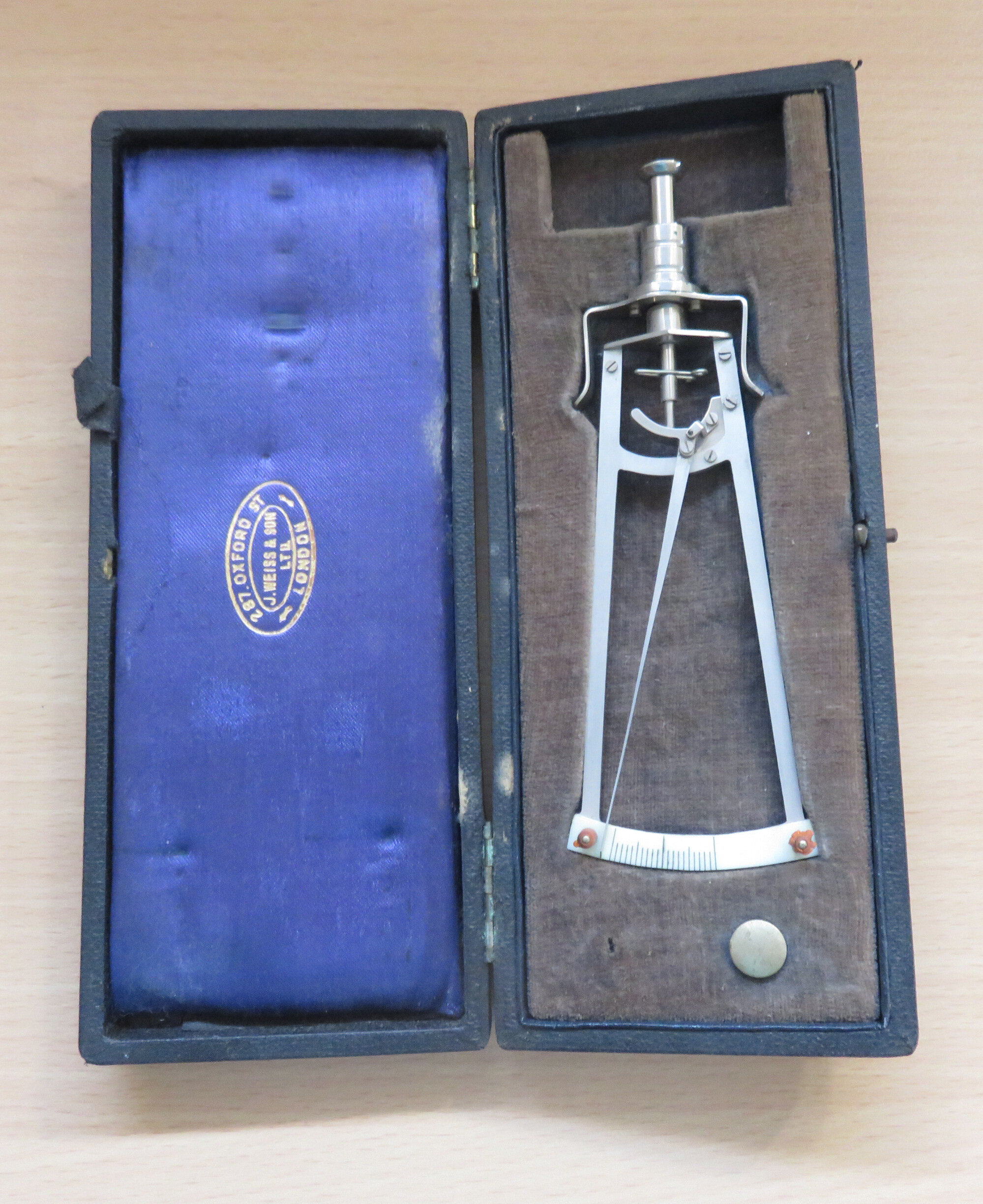Measuring, diagnosing, treating.
The Maitland Hospital Collection includes an eclectic variety of medical and surgical equipment and instruments.
As a group, the health and medical equipment and instruments are representative of the changing health practices and the equipment developed to support those practices. They tell stories about inventions and improvements, and have the potential to evoke memories and details from staff and community members who have used, or been treated by, some of the items.
Some of the medical and surgical items and equipment on display in the exhibition A Conspicuous Object - The Maitland Hospital, Maitland Regional Art Gallery, October 2021.
Details of some items are provided below.
Anaesthesia masks and bottle
Anaesthesia masks, early to mid twentieth century.
(Maitland Hospital Collection 199)
These wire frame masks were used for delivering anaesthetics. The frames were covered with cotton gauze or fabric and placed over the patient’s mouth and nose. The anaesthetic was dripped on to the fabric allowing the patient to inhale a mix of the evaporated anaesthetic and air.
Drip anaesthesia bottle.
(Maitland Hospital Collection 104)
Small bottle used to drip anaesthetic on to the gauze of an anaesthesia mask.
Breast reliever
Breast reliever in box, Minson Scientific Company, Sydney.
(Maitland Hospital Collection 269)
This is a manual pump for extracting mother’s milk from the breast. It is a trumpet shaped glass appliance with a rubber bulb at one end that is squeezed to create suction. It is packaged in a cardboard box that has an image of the breast reliever and, on the side, the information: ‘This instrument is of Pyrex Glass full 25 ml capacity, with strong rubber bulb. Approved by leading hospitals. Minson Scientific Company, Sydney.’
The breast pump is significant for its association with the maternity services offered by the Maitland Hospital over its history. It is also representative of earlier forms of breast relief equipment.
For an overview of the history of the breast pump visit ‘The sucky history of the breast pump’, Smithsonian Magazine, 12 September 2022 (accessed October 2022).
For accounts of the maternity ward and maternity services at Maitland Hospital, click on the ‘maternity’ tag at the end of this posting.
Cystoscope
Brown-Buerger Cystoscope
(Maitland Hospital Collection 175)
A cystoscope is a thin tube with a camera and light at the end that is inserted through the urethra (the tube that carries urine out of your body) to the bladder. It is used for both diagnosis and treatment.
The cystoscope developed from nineteenth century procedures involving external light sources (including oil lamps fuelled by alcohol and turpentine!) and took over a century and many innovations to be developed into an effective medical instrument.
The Brown-Buerger cystoscope was introduced in 1907, and became a standard instrument until replaced by modern lens systems in the 1970s.
The British Association of Urological Surgeons provides a timeline of cystoscopes.
Hemometer
Hellige Sahli hemometer in duplex case (incomplete).
Includes two pages of technical information.
(Maitland Hospital Collection 217)
The Hellige Sahli hemometer was developed in the early twentieth century by Swiss physician Hermann Sahli (1856-1933) as a tool for estimating the level of haemoglobin in a patient’s blood. In the 21st century this task is done by automated machines.
Pacemakers
Cardiac pacemakers, 1990s
(Maitland Hospital Collection 333)
A pacemaker is a small device that is placed in your chest to help control your heartbeat. The first pacemakers were implanted in the 1960s. Improvements in technology have seen the devices become much smaller, more responsive and more long-lasting.
Retractors
Self-retaining retractors
(Maitland Hospital Collection 205)
Retractors are used to separate the edges of an incision or wound during surgery. Self-retaining retractors like these two examples, do not need to be held once inserted. The ratchet holds the two arms in place.
‘P.T.S.’ is etched on the smaller retractor; ‘O.T.’ on the larger retractor.
P.T.S. refers to the Preliminary Training School for nurses that functioned in the hospital.
O.T. refers to ‘Operating Theatre’.
Southey’s tubes
Southey’s tubes, Arnold and Sons, London, early to mid-twentieth century (incomplete).
(Maitland Hospital Collection 190)
Created by, and named after, British physician Reginald Southey (1835-1899), Southey’s tubes were inserted under the skin in order to drain off excessive fluid.
Comparative examples can be seen on the website of the UK Science Museum Group.
Thermometers
Clinical thermometers - glass and mercury, cardboard case (left) and wooden case (right), later twentieth century.
(Maitland Hospital Collection 111 and 112)
Temperature is taken by placing the thermometer in either the mouth or the rectum. A normal body temperature is 98.4° Fahrenheit (37° Centigrade), and rises in body temperature can indicate fever. In the early 1900s doctors began constructing fever charts that recorded the temperature patterns of specific illnesses. Thermometers became important measuring and diagnostic tools.
Dr Forbes-type bath thermometer.
(Maitland Hospital Collection 113)
This thermometer was used to measure the temperature of baths given to patients as part of their medical treatment. The scale is measured in Fahrenheit and is marked with the temperature of water when it is freezing (0-32°F), cold (45°F), cool (66°F), tepid (86°F), warm (98°F), and hot (105°F).The type of thermometer was invented by Dr John Forbes (1787-1861), a Scottish physician. (Science Museum UK)
Tonometer
Schiøtz tonometer, metal in leather covered case, J. Weiss and Sons London.
(Maitland Hospital Collection 168)
Tonometers measure the internal pressure of the eye and are an important tool for diagnosing glaucoma. Today there are non-contact tonometers: the pressure is measured by a gentle ‘puff-of-air’.
The Schiøtz tonometer, created by Norwegian Hjalmar Schiøtz (1850-1927) in the early twentieth century, became accepted as the most reliable instrument to measure the internal pressure of the eye until well into the twentieth century.
The UK College of Optometrists provides an overview of the development of tonometers.
First posted: 13 October 2021
Updated: 20 October 2022













